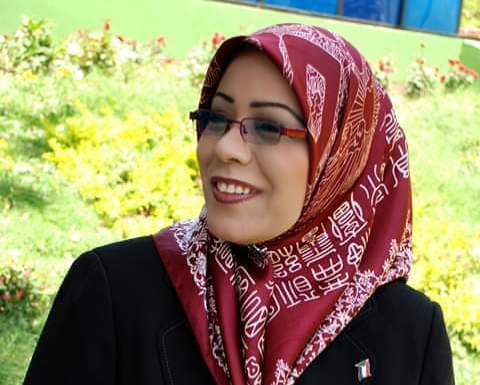Opinion
The Theft of Antiquities is an International Crime

Written by: Dr. Inas Mohamed Ahmed
Sudan is one of the countries blessed by God with a rich civilization and a distinguished geographical location. It is the gateway to Africa from the east and has a strategic and impactful coastline on the Red Sea. God also blessed it with the Nile River, which uniquely combines the White and Blue Nile at the confluence of the two rivers, a rare phenomenon admired worldwide, unmatched anywhere on earth. For these reasons and many others, Sudan became the cradle of ancient human civilizations. It was coveted by invaders, facing conquests and occupation throughout both ancient and modern history. Yet, in each instance, the Sudanese nation’s will prevailed, as history has recorded numerous heroic acts and victories by the proud Sudanese people. This legacy has made Sudan a land full of archaeological sites that narrate the history of this great nation from ancient times.
Throughout history, humanity has suffered the devastations of war. The suffering goes beyond death, displacement, and destruction, extending to the loss of infrastructure, national achievements, and the destruction of cultural and historical heritage. Wars have led to the destruction of archaeological sites, looting of museums, and the theft and smuggling of rare artifacts. This results in the loss of a nation’s historical memory, the erasure of its historical records, and the loss of evidence of its development over the ages.
Recently, a disheartening report surfaced regarding looting and theft at the Sudan National Museum, its attached storeroom housing rare treasures, and other Sudanese museums across the country. Videos released in June 2023 showed militia soldiers roaming inside the National Museum and tampering with its contents. This museum is located near the confluence of the Blue and White Nile in a prime tourist location in Khartoum. It was officially opened in 1971 during the presidency of Jaafar Mohamed Nimeiri, though it was initially founded in 1904 at the University of Khartoum before being moved to its current location.
The National Museum holds a vast collection of Sudanese artifacts, including statues, sculptures, ornaments, stoneware, copper, leather, bronze, iron, wooden tools, historical manuscripts, and royal furniture from various periods, from the Stone Age through the Christian, Nubian, and Islamic eras. The old Republican Palace, a historical treasure, has also been damaged, along with the thefts from the War Museum, the Khalifa’s House Museum, the Anthropology Museum, the National Records House, and the Nyala Museum in South Darfur. The militia has turned museum buildings into administrative offices for its forces.
Supporting these claims, satellite images have shown large trucks loaded with Sudanese artifacts heading towards South Sudan. The National Museum and the Sudanese Center for Cultural and Historical Research have called on the South Sudanese government to help track these trucks and arrest the criminals attempting to flee. They urged cooperation with the Sudanese Ministry of Culture, the Sudanese Embassy in Juba, and international efforts to recover the stolen artifacts. This came after UNESCO issued a call for action when some of these stolen items appeared for sale online. These items originated from various sites across Sudan, including Shiheinab, Khor Abu Anja, Sennar, and others, with pieces from the Napatan period (the second Kushite kingdom), Gebel Barkal, Al-Kedro, Nuri, the Merowe civilization, Naga, Al-Massawarat, Al-Bajrawiya, and Islamic periods.
The contents of these museums are the result of extensive archaeological research efforts by archaeologists and numerous archaeological missions spanning hundreds of years, many of which are listed on the World Heritage List.
The World Protects Antiquities
Since antiquities and archaeological sites represent a historical record of a nation’s life and creativity over time, and are key components of a civilization’s identity, their protection is essential on a global scale. In response to the widespread destruction of historical sites during World War II, the international community sought to limit the damage to these sites during wars and conflicts. This began with the Paris Agreement in 1815, the Lieber Code in 1863, and the International Protection of Antiquities Agreement of 1885. These protections evolved through the Hague Convention and its annexes in 1899 and 1907, which emphasized the prosecution of those who attack cultural property and historical sites, and continued with the Washington Agreement of 1935 and the Roerich Pact in 1935, named after the Russian scholar Nicholas Roerich, who advocated for the protection of cultural institutions, science, and antiquities.
UNESCO, founded on November 16, 1945, with its headquarters in Paris, has played a major role in protecting archaeological sites and world heritage. Based on a proposal from the Netherlands, the Hague Convention was ratified on May 14, 1954, along with a legal implementation protocol, and an additional protocol followed on March 26, 1999, fifty years later. This second protocol introduced the concept of enhanced protection for archaeological and cultural sites, which only applies to the signatory states of the 1954 Hague Convention, alongside the development of international humanitarian law, international criminal law, and cultural heritage law. Additionally, Protocol I of the 1977 Geneva Conventions contains articles related to the protection of cultural property and antiquities.
International law obliges states in times of armed conflict to refrain from using museums, archaeological sites, and cultural property for military or administrative purposes that might expose them to damage or destruction. States must also avoid attacking them and take measures to monitor and protect these cultural entities.
The international community sought to mark cultural sites, including museums, with distinctive signs for easy recognition. The 1954 Hague Convention adopted a special emblem: a downward-pointing shield divided into white and blue sectors, to be placed in a visible location. The Red Cross International Organization also played a significant role in protecting civilian objects during wars.
Several conferences were held to protect antiquities, archaeological sites, and museums, such as the Venice Conference in 1970, the Accra International Conference in the same year, and the Helsinki Conference in 1972, followed by the Jakarta International Conference in 1973.
The 1954 Convention prohibits discrimination in the protection of antiquities, regardless of national, religious, or ethnic affiliations, and extends protection to cultural, historical, educational, artistic, scientific, or archaeological institutions.
The convention stipulates that the following acts constitute a violation of cultural property:
1.Targeting or attacking protected cultural property or antiquities.
2.Using cultural property for military purposes or utilizing vital targets located near these properties for military support.
3.Causing large-scale destruction or seizure of protected cultural or archaeological property.
4.Looting, theft, or vandalism of protected cultural property.
Each state must enact the necessary legislative measures to establish its jurisdiction over the aforementioned crimes if:
1.The crime is committed on its territory.
2.The accused is a national of that state.
3.The accused is present in the state’s territory.
The Rome Statute of the International Criminal Court, which came into force on July 1, 2002, classifies attacks on buildings dedicated to religious, educational, cultural, artistic, or charitable purposes, or historical monuments or museums, as war crimes, provided these buildings are not used for military purposes. The court has jurisdiction over these crimes, without prejudice to the jurisdiction of national courts according to each country’s domestic law.
The country of origin also has the right to file lawsuits in the courts of the state where the artifacts have been smuggled to request their return if they were obtained illegally.
The Principle of Artifact Restitution
This principle emerged when European countries demanded the return of artifacts looted by Napoleon during wars, as articulated at the Congress of Vienna in 1815. Many peace treaties up until the late 19th century included provisions requiring countries to return illegally acquired artifacts.
Likewise, the Allies demanded the return of artifacts looted by the Nazis through the London Declaration of 1943, and at the Paris Conference of 1945, they demanded reparations.
These claims laid the groundwork for the principle of artifact restitution, leading to the United Nations Convention on the Protection of Cultural Property during Armed Conflicts in 1954 and its subsequent protocols. The 1970 Convention further strengthened this principle by addressing the prevention of illegal import, export, and transfer of cultural property, considering such acts as crimes.
This was followed by the 1995 Rome Institute Agreement, adopted by UNESCO, which mandates the immediate return of stolen or illegally acquired artifacts.
As the principle of restitution gained traction, the UN Security Council issued numerous resolutions requiring the return of stolen artifacts from countries or regions that experienced armed conflict or terrorism. Among them was the landmark Resolution 1483, which tasked UNESCO, Interpol, and other international organizations with implementing the provision for the return of stolen cultural property under Paragraph 7 of the resolution in 2003.
At the regional level, Sudan is also committed to the African Cultural Charter of 2006, which calls for the restitution of African artifacts. International non-governmental organizations, such as the African Museums and Archaeological Sites Organization (OMSA), the African Institute for Scientific and Anthropological Research established in Mauritania in 1972, the African Cultural Center in Botswana, and the African Documentation Center in Mali, also participate in these efforts.
Restitution Methods Include:
1.Diplomatic Means: This involves friendly negotiations based on strong diplomatic relations between states, guided by diplomatic customs and traditions. Ownership documents proving the country’s rights to the artifact are presented, and the artifact is returned through mutual agreement.
2.Filing a Lawsuit for Artifact Restitution: This follows the legal procedures of the country of origin, with Interpol notified, and information, photos, and documents submitted. The artifact is returned after a legal ruling.
3.International Arbitration between the States:
In 2016, for the first time, the International Criminal Court (ICC) classified the destruction of antiquities as a war crime. On September 27, 2016, the court sentenced a member of an extremist group in Mali for destroying historical shrines in his country, which had been listed as UNESCO World Heritage sites.
Since Sudanese antiquities are considered public property for all Sudanese, every Sudanese citizen has the right to defend them. They are not subject to statute of limitations, cannot be disposed of, nor can they be relinquished. Therefore, I call on UNESCO, the International Council on Monuments and Sites (ICOMOS), the International Council of Museums (ICOM), the International Documentation Council, the World Heritage Fund (WHF), the Arab League Educational, Cultural, and Scientific Organization (ALECSO), the Islamic Educational, Scientific, and Cultural Organization (ISESCO), and all regional and national organizations concerned with antiquities and archaeological sites to support Sudan’s demand for the restitution of its cultural heritage and to return the stolen and looted Sudanese artifacts.
Additionally, these organizations should work to track down the perpetrators, bring them to justice, and prosecute them. This is the least that can be done to recover our country’s antiquities and preserve the identity and legacy of our ancestors.
This land belongs to us.
Oh Lord, grant victory to our army, for You are the only true source of victory.
In 2016, for the first time, the International Criminal Court (ICC) classified the destruction of antiquities as a war crime. The court issued a historic ruling on September 27, 2016, sentencing a member of an extremist group in Mali to prison for destroying historical shrines in Timbuktu, which were inscribed on the UNESCO World Heritage List.
Since Sudanese antiquities are considered public property for all Sudanese people, it is the right of every Sudanese citizen to defend them. These artifacts are not subject to any statute of limitations; they cannot be sold or transferred, nor can they be relinquished. Therefore, I urge UNESCO, the International Council on Monuments and Sites (ICOMOS), the International Council of Museums (ICOM), the International Council for Documentation, the World Heritage Fund (WHF), the Arab League Educational, Cultural, and Scientific Organization (ALECSO), the Islamic Educational, Scientific, and Cultural Organization (ISESCO), and all regional and international organizations concerned with the protection of antiquities and archaeological sites to support Sudan in its call for the restitution of its cultural heritage. It is essential to recover the looted and stolen Sudanese artifacts and to track down and prosecute the criminals involved.
This is the least we can do to reclaim our nation’s treasures and to preserve the identity and heritage of our ancestors.
This land belongs to us.
May God grant our army a glorious victory, for there is no victor but You.
We shall continue to call upon the international community, human rights organizations, and heritage protection groups to stand with Sudan in its legitimate demand to recover its stolen and looted heritage. These antiquities are not just objects of historical significance but symbols of our identity, culture, and the rich legacy of our ancestors. They carry the story of our nation’s journey through time, from the ancient Kushite kingdoms to modern-day Sudan.
As we press forward, we recognize that recovering these artifacts is not only about restoring physical pieces of history but about safeguarding our cultural memory and ensuring that future generations understand their roots and heritage. The theft and destruction of these treasures are attacks not just on the Sudanese people but on humanity as a whole. Every stolen artifact represents a chapter of history lost, a piece of our shared human story erased.
The responsibility to protect and preserve these priceless artifacts is not limited to Sudan alone. The international community must uphold its commitment to the conventions and agreements designed to prevent the looting and destruction of cultural heritage during times of conflict. The rule of law must prevail, and justice must be sought for all those responsible for these heinous crimes.
We, as Sudanese, will not rest until every stolen piece of our history is returned, until the criminals who have violated our heritage are held accountable, and until our nation’s cultural pride is restored.
This is our mission, and we shall continue.
May God protect our nation and its treasures.



